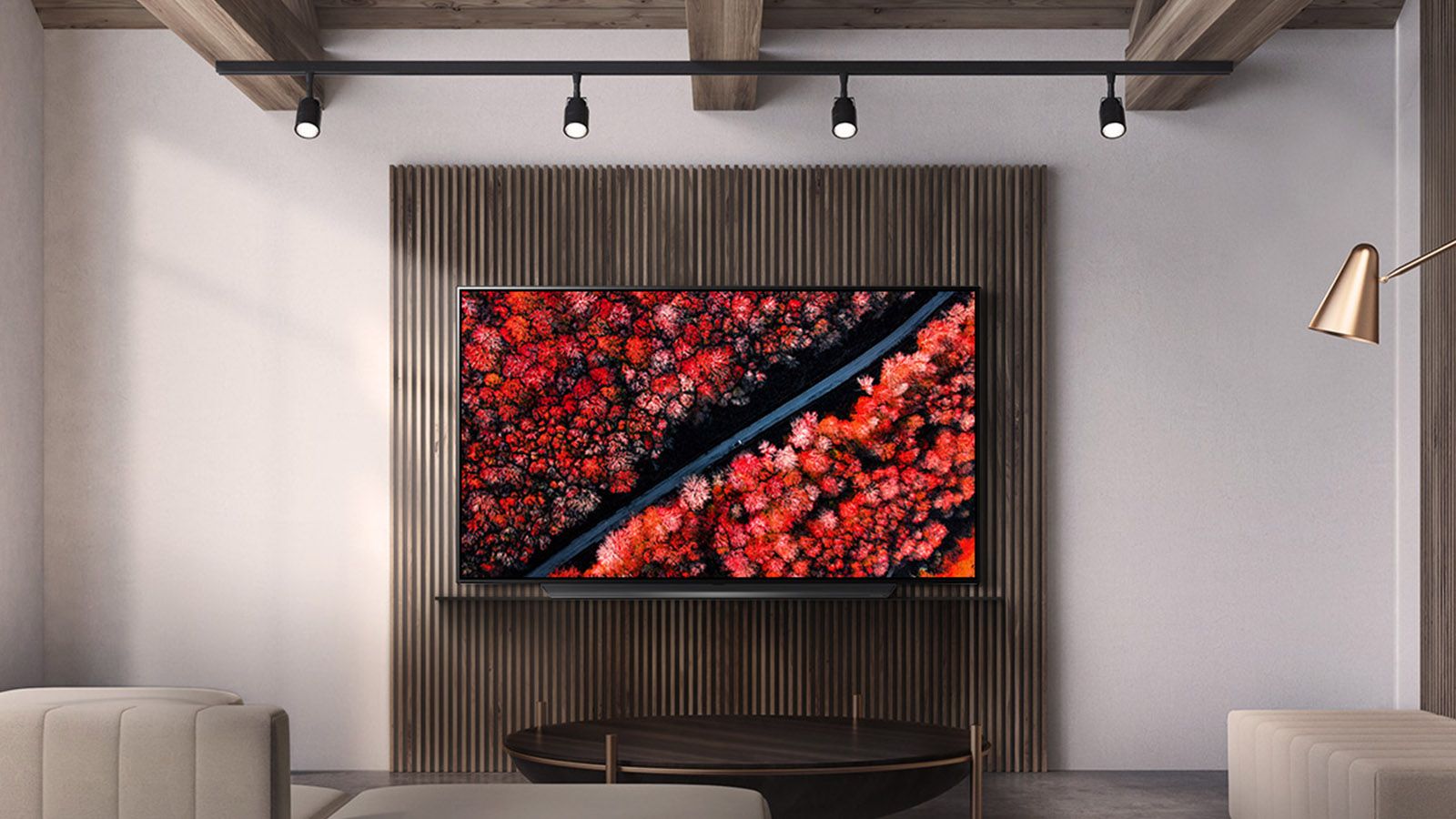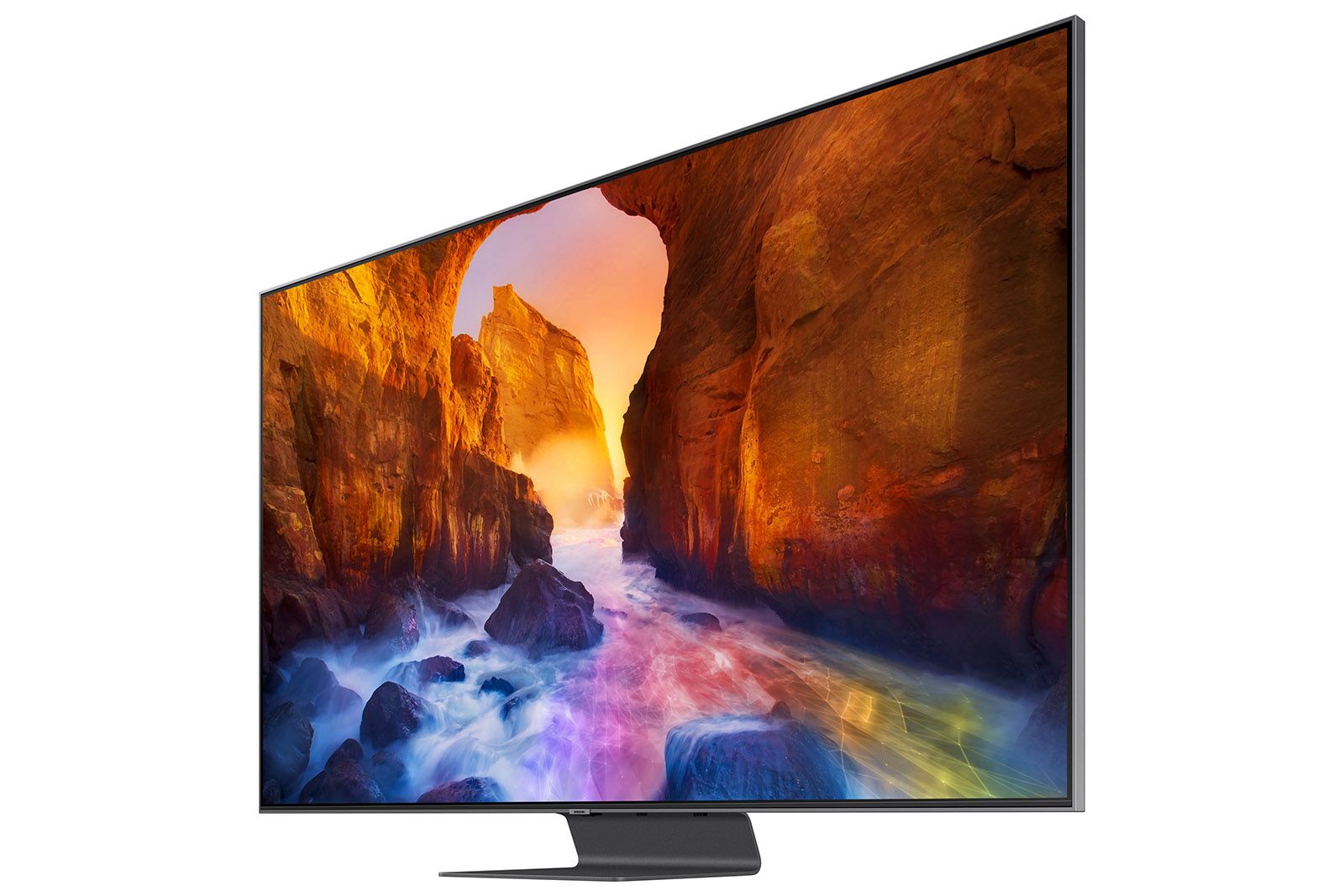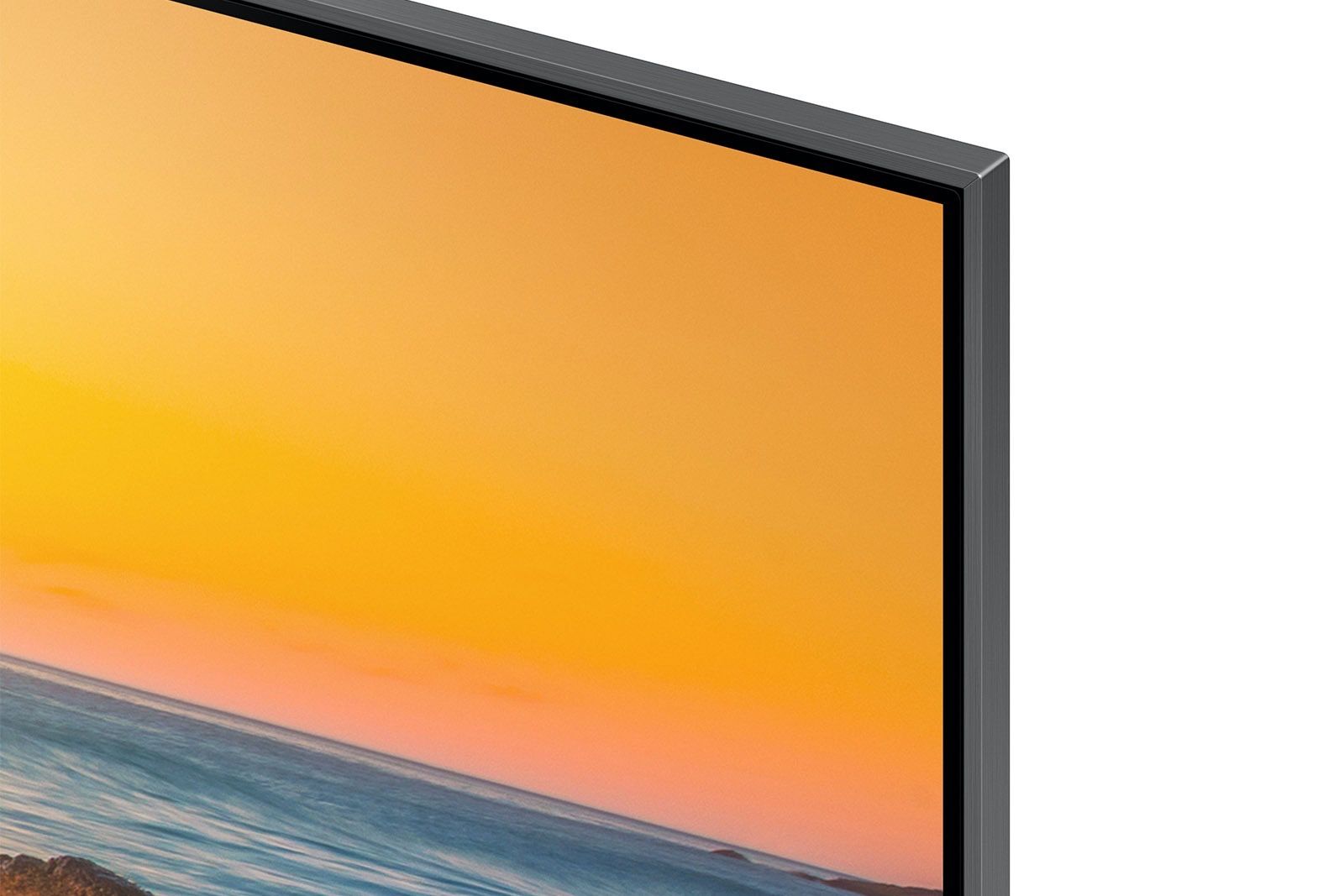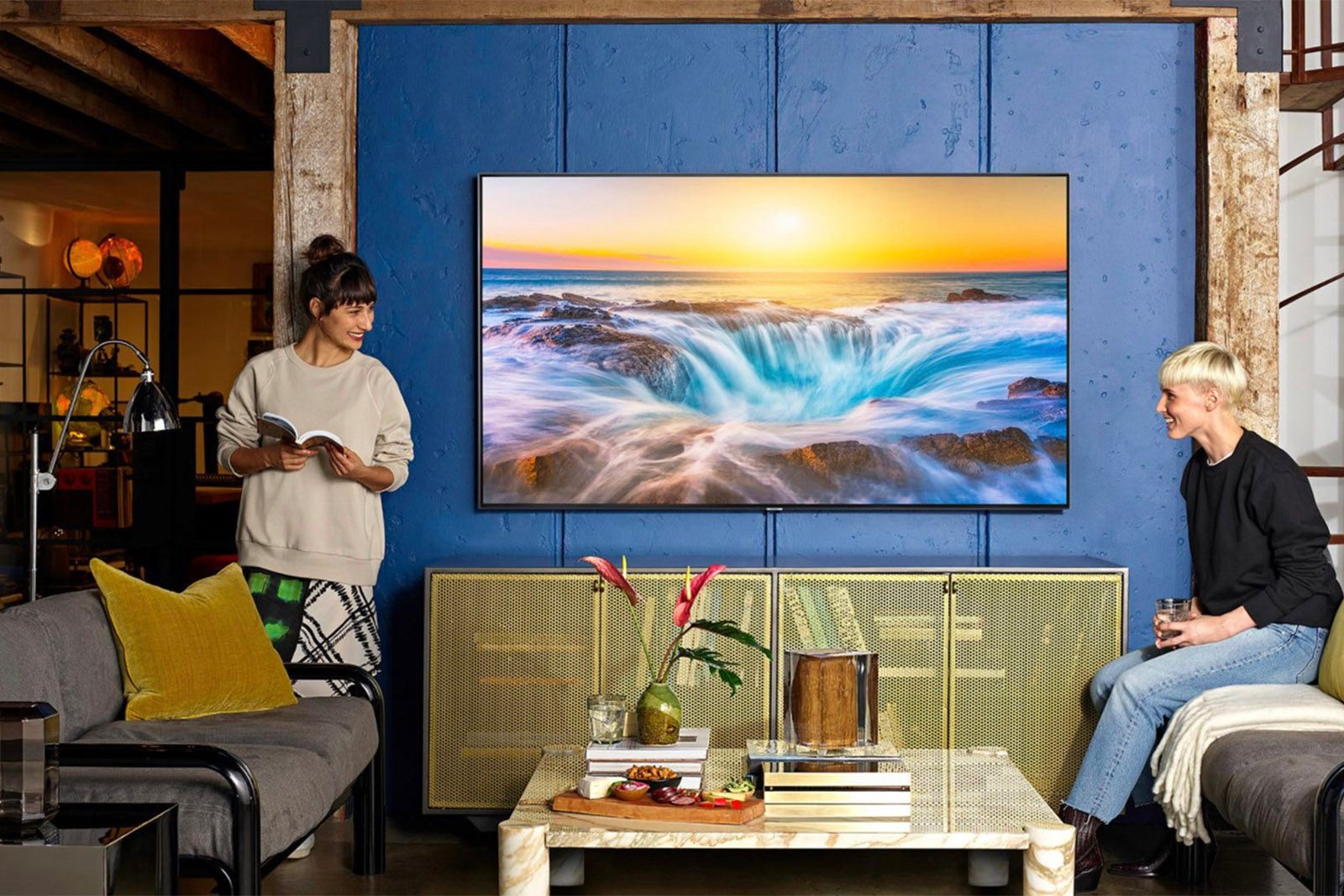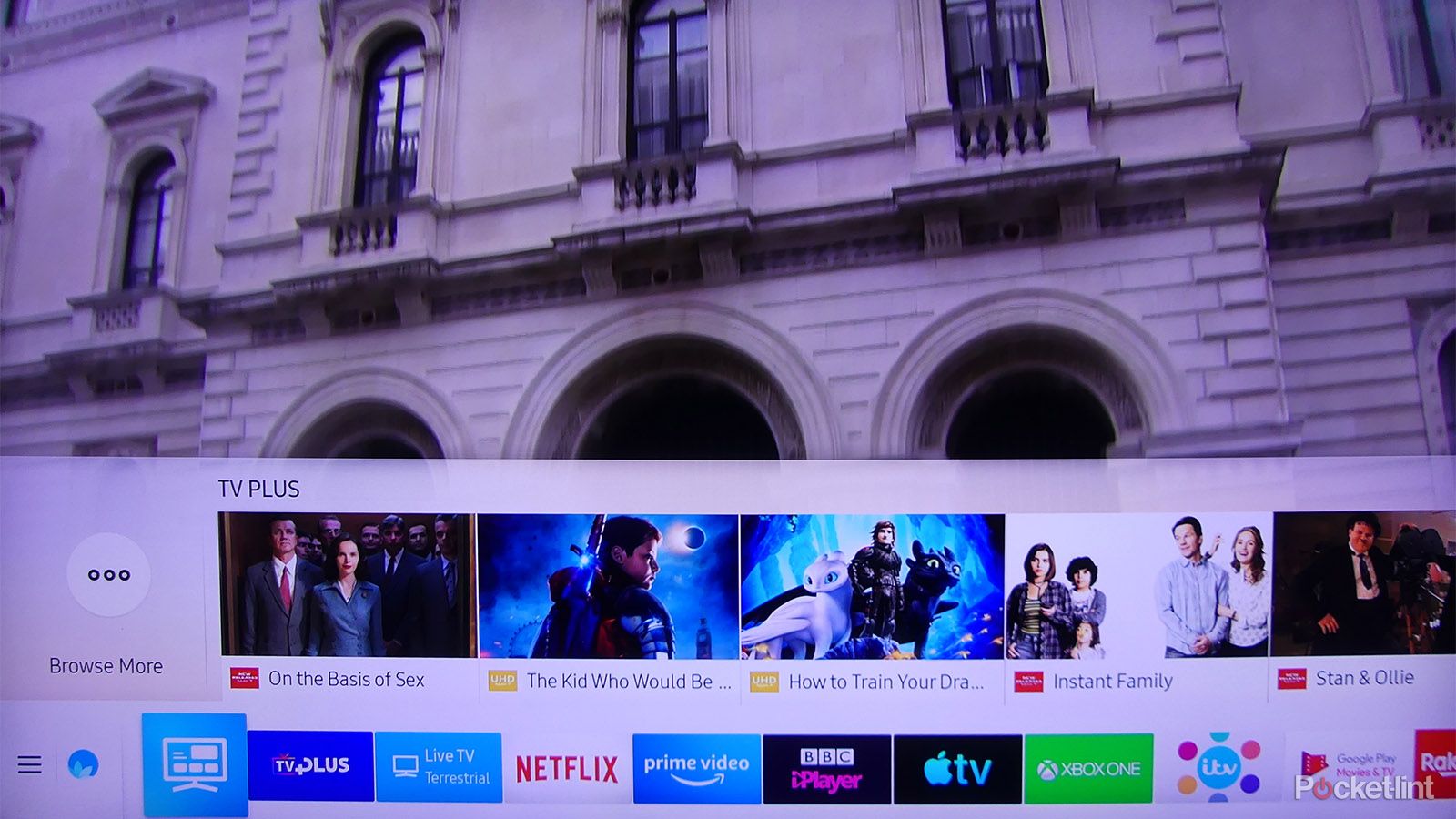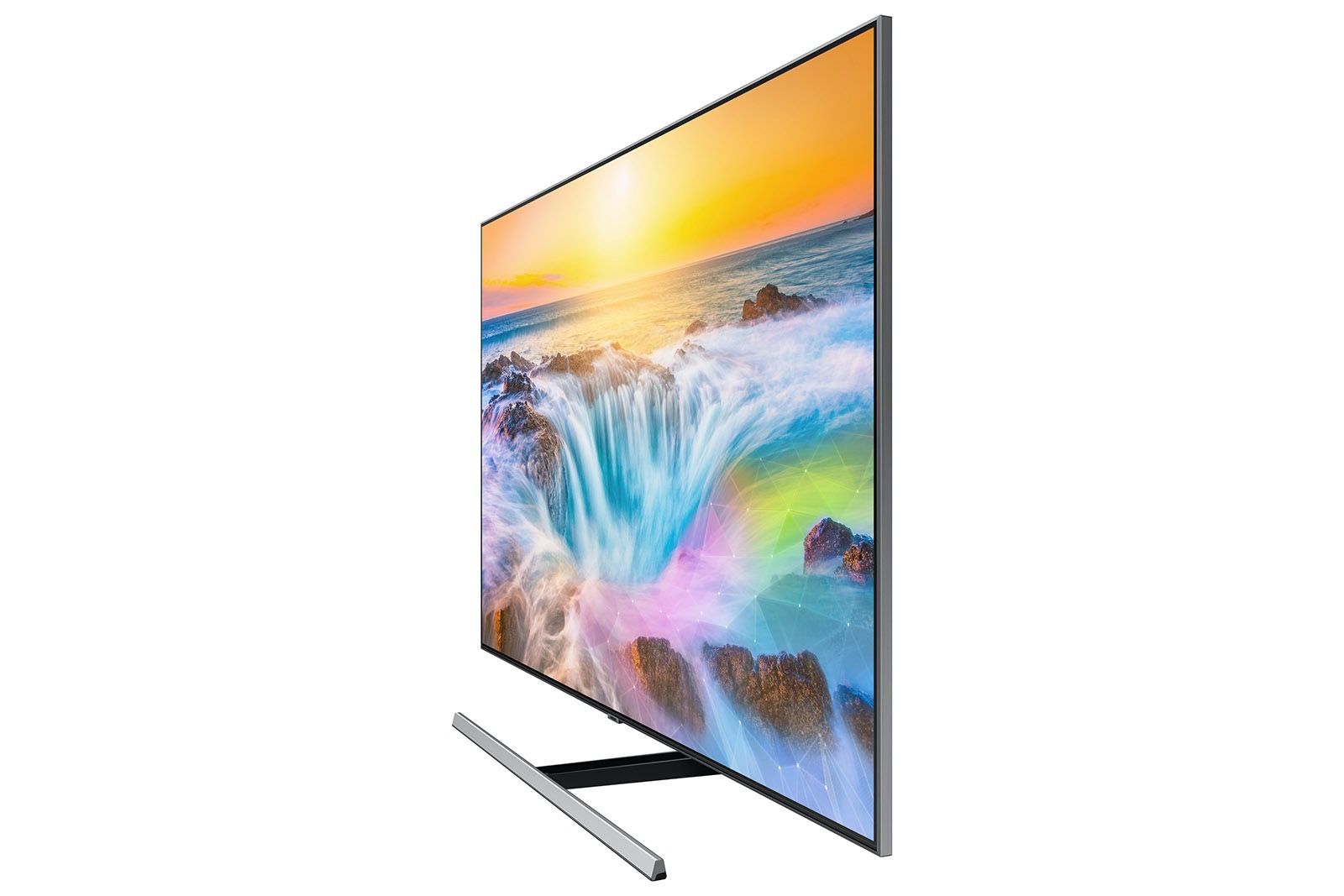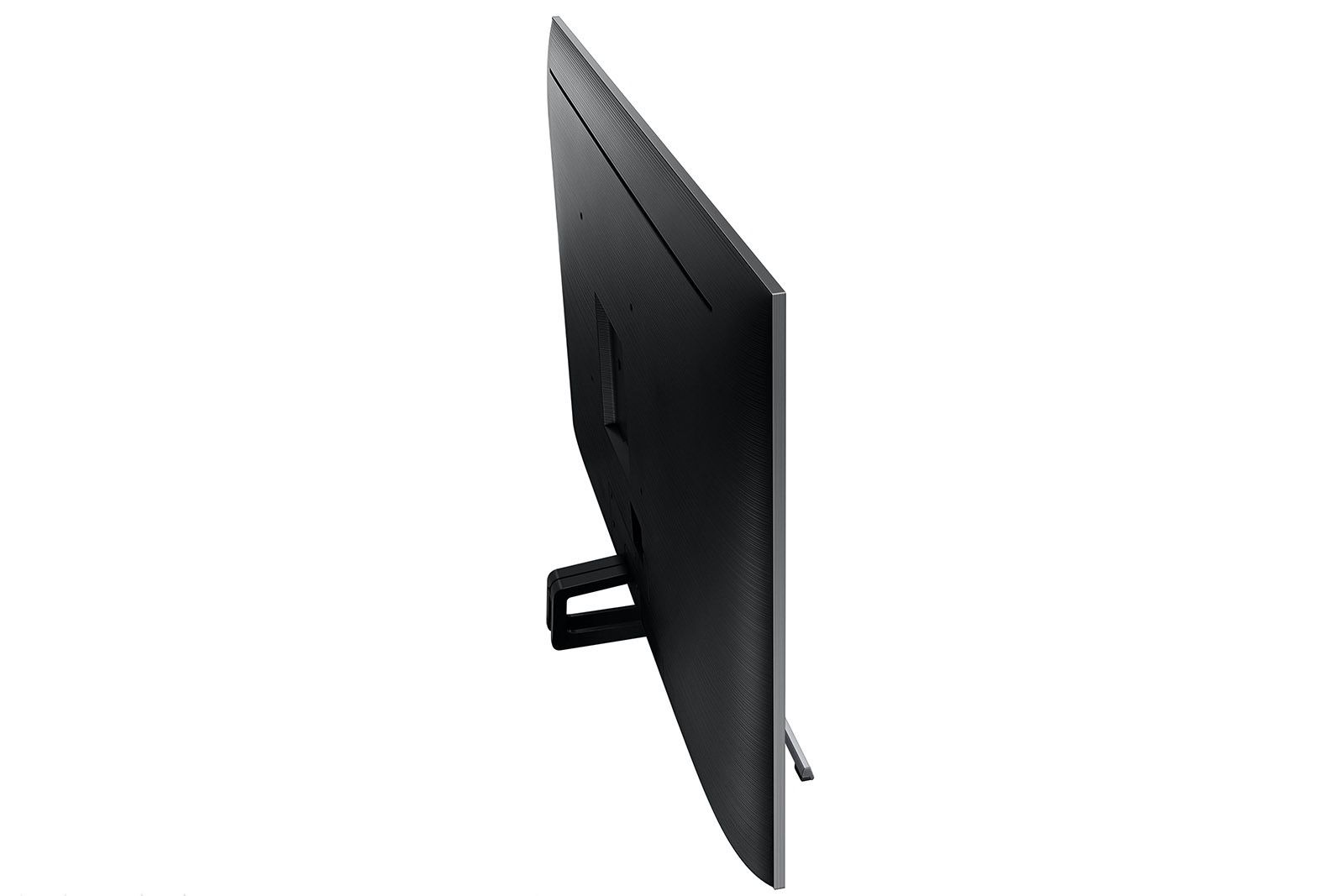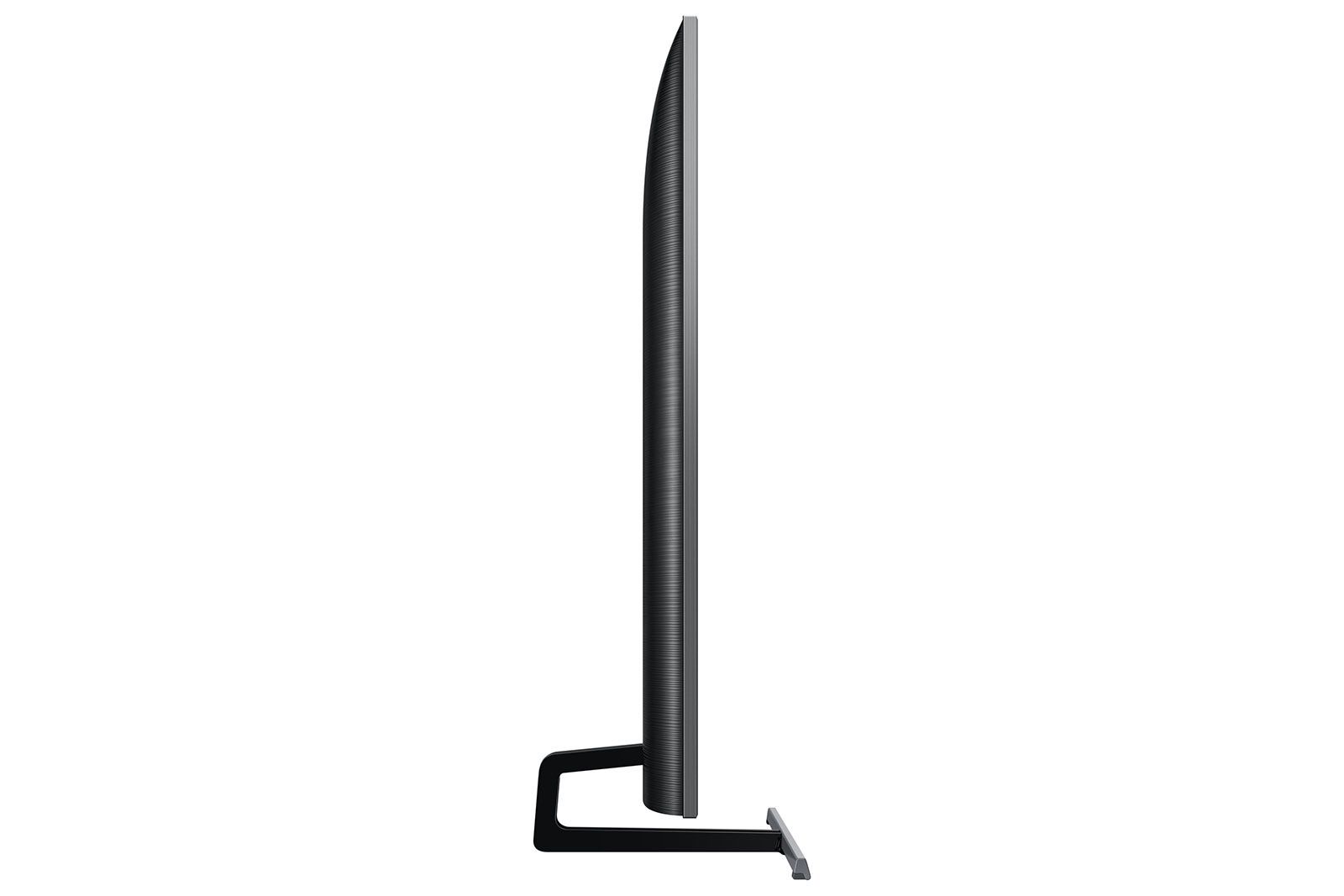The 2019 Samsung QLED 4K TV range raise the LCD TV bar in spectacular fashion, especially the Q90R flagship which we've previously reviewed. However, this top-of-the-line model is a serious financial commitment, costing £2,600 in its 55-inch form at the time of writing.
Cue the Q85Rs: the step-down model in the range, offering much of the technology that makes the Q90R so special - but for hundreds of pounds less. Yes, it's still close to two grand, but as the 55-inch model on review here is almost £600 cheaper than its equivalent Q90R sibling, surely it's going to be the one to choose?
But that raises one obvious question: what's the catch?
Our quick take
The Q85R is another hugely impressive QLED TV from Samsung. Its pictures do things LCD TVs aren't supposed to be able to do (despite the lack of Dolby Vision support), and get surprisingly close to the class-leading images of Samsung's Q90R flagship models for a handy £500 less.
That's the long and short of it really: if you want super-bright, you'll have to spend a bit more; if you want deeper blacks you'll need to consider OLED; but as an in-between yet very high-end result, the Q85 is a near perfect balance of picture performance.
Alternatives to consider
LG OLED55C9
LG OLED55C9
The 55OLEDC9's combination of aggressive pricing (at £1,999 it's £100 cheaper than the 55Q85R) and excellent picture quality really is outstanding. It can't get as bright or deliver as much colour volume as the 55Q85R, but its OLED-driven black levels and lighting precision are beautiful.
Samsung QE55Q90R
Samsung QN65Q90R (2019)
Samsung's flagship 4K LCD TVs for 2019 deliver hundreds more dimming zones than the Q85Rs, helping it produce deeper blacks, more contrast, and even richer colours than the Q90Rs. Though the 55-inch will cost you £500 more than the 55Q85R.
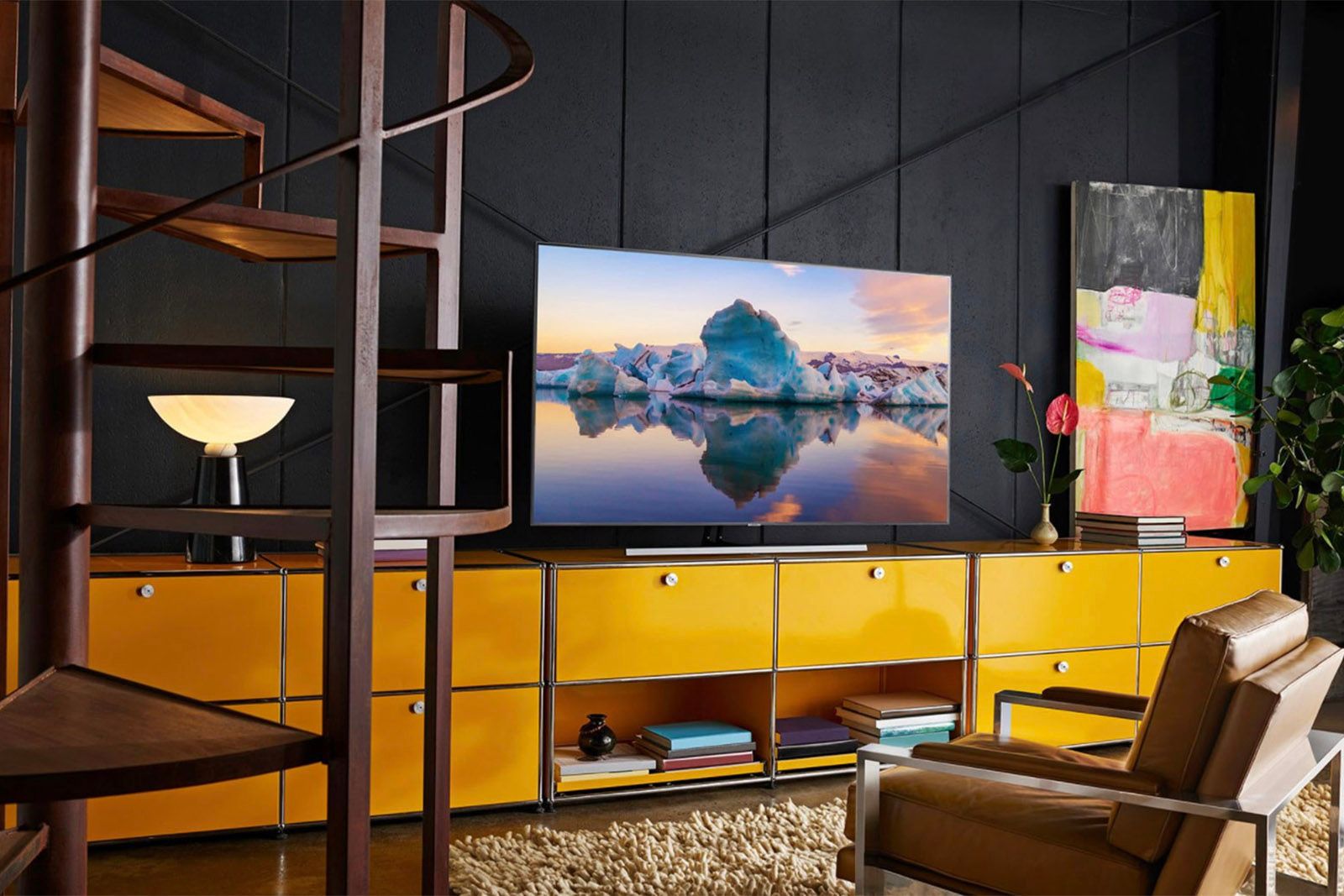
Samsung Q85R 4K TV - 4.5 / 5
| FOR | AGAINST |
|---|---|
|
|
SAMSUNG QE65Q85R
Samsung QE55Q85R: Design
- One Connect box, no ports on TV itself
- 4x HDMI inputs, 3x USB ports
- LAN & Wi-Fi network options
The Q85R is a seriously attractive TV. From the front, its exceptionally narrow bezel, open neck design and minimalistic silver bar desktop support give it a remarkably airy, light, almost floating look for such a large TV.
The set's rear is a bit chunkier than the norm these days. But it boasts an attractive brushed finish for anyone interested in looking at the wrong side of their TV for whatever reason.
As with the Q90R, the Q85R ships with an external One Connect connections box that passes all pictures, sound and even power to the screen via a single surprisingly skinny, light-coloured cable. This makes the set a great option for people thinking of wall hanging their TV - or for anyone who just hates cable spaghetti.
The Q85R boasts Samsung's Ambient Mode technology, too. This can display a wide variety of video, photograph or digitised artwork screensavers on the TV (in a low power mode) when you're not watching it properly. Far preferable to just leaving a big black rectangle in the room when the TV's in standby.
It's even possible to take a photograph of the wall the TV is set against and then play that photo on the screen, to optimise the Ambient Mode's 'blend in' potential.
Connections on the external One Connect box are pretty much as expected with a high-end 4K TV. There are four HDMI ports, three USB ports, tuner inputs, and support for Wi-Fi and Bluetooth networking. The only thing missing is a headphone jack, since the TV only supports Bluetooth headphones.
It's worth noting that while the HDMI ports support some features associated with the latest HDMI 2.1 specification (more on this in the next section), they are not full-bandwidth (48Gbps) HDMI 2.1 ports of the sort provided on LG's latest 4K OLED TVs, like the C9.
Samsung QE65Q85R: Picture Features
- HDR Support: HLG, HDR10, HDR10+
- Processing engine: Quantum 4K processor with AI and wide viewing angle support
The Q85R carries most of the key features that helped make the Q90R range so stellar. This includes a direct LED lighting engine (where the lights sit right behind the screen) and an advanced local dimming system.
However, this backlight system also provides the main difference between the Q85R and its more expensive siblings: while the Q90R carry 480 dimming zones, the Q85R only has 100.
In every other way, though, the Q85R delivers all of Samsung's latest and greatest picture technologies. Including the new wide-angle support, which uses a combination of a new screen design and sub-pixel manipulation to let you watch from almost any angle without pictures losing contrast or colour saturation like LCD TVs normally do when viewed off axis.
This approach does theoretically reduce the screen's resolution slightly. Such is the strength of the TV's sharpness processing, though, that it's seriously hard to notice this in a real world viewing situation. Note that the wide viewing angle tech is turned off if you're using the TV's Game Mode.
The set's 4K AI system uses a huge and ever-evolving database of comparisons of different resolution versions of the same content to deliver its upscaling of sub-4K sources, rather than the old approach of trying to calculate how new pixels should look based on analysis of neighbouring 'real' pixels.
The Q85R is a QLED model, meaning it uses Quantum Dots to produce its colour rather than the cheaper and more traditional LCD colour filter system. Samsung's Quantum Dots are clad in metal sheaths, so that they can be driven harder to deliver more brightness and a wider colour range - key requirements for delivering a convincing high dynamic range (HDR) picture.
The Q85 can pump out around 1500 nits of brightness. The Movie preset delivers more sustained peak brightness, but 'only' at 1200 nits.
The Q85R's HDR pictures can appear in the industry standard HDR10 format, the broadcast/live stream HLG format, or the dynamic HDR10+ format. This last system adds scene-by-scene data to help compatible TVs deliver a more dynamic HDR experience.
As with all Samsung TVs, though, the Q85R does not support the Dolby Vision dynamic HDR format used by many film studios for both streamed and 4K Blu-ray titles.
Other notable features for gamers include automatic switching to the low-input lag game mode when game sources are detected, support for variable refresh rates (both these features are associated with HDMI 2.1 ports, even though the Q85R doesn't carry one!), and a picture setting that raises the brightness of dark parts of a game picture without impacting the bright parts, to make enemies lurking in the darkness easier to spot. Input lag (the time it takes for a TV to produce pictures after receiving picture data at its inputs) measures under 15ms in Game Mode, which is a great result.
Finally, while the Q85R supports some features associated with the new HDMI 2.1 standard (the Auto Low Latency Mode switching and VRR support), the fact that its HDMI ports don't support 48Gbps may limit its ability to handle the extremely high frame-rates in 4K being talked about for the next-generation of game consoles.
Samsung QE75Q85R: Smart Features
- Smart system: Eden 2.0, based on a Tizen OS
Samsung's latest smart engine continues to refine its Tizen-based Eden UI, to the point where it's now a mostly helpful and thoughtful system.
The home screen is based on two tiers of icons: a bottom layer providing access to everything from apps to the TV's settings, Ambient Mode and TV listings; and a second layer that delivers direct links to TV shows and features associated with the option you've got selected on the bottom layer.
Navigation is reasonably rather than amazingly slick and responsive, and it's good to see the menus only covering around the bottom quarter of the picture, leaving you able to keep watching TV while you browse.
Samsung's built-in voice recognition functionality for control and search is excellent, recognising voices accurately and allowing you to use your voice to access almost every part of the Q85R's setup menus. There's support for Amazon Alexa and Google Assistant voice control too, but only via external listening devices.
Samsung's app support continues to be comprehensive. All the usual video streaming services are here: the catch-up services for the main terrestrial TV broadcasters, Netflix, Amazon Prime Video, Now TV, YouTube, Google Play Movies & TV, Rakuten and so on. Plus there are a couple of important but much less common apps: Apple TV and BT sport.
It would be nice if Samsung followed the lead of pretty much every other TV brand and included the Freeview Play app among its services, to make it easier to find shows on the terrestrial TV catch-up platforms. Though the Q85R does carry Samsung's own TVPlus system, which aggregates recommended tuner and on-demand sources from a variety of platforms into a single interface area.
Samsung QE82Q85R: Picture Quality
The Q85R's pictures aren't as all-round spectacular and refined as those of Samsung's Q90R flagship. But the gap is not nearly as pronounced as you might expect given that the Q85R is considerably cheaper.
Particularly remarkable is how well the Q85R handles having nearly 400 fewer local dimming zones. Remarkably, there's hardly any significant backlight blooming around stand-out bright objects, even when watching HDR sources. Despite the fact that the set also produces exceptionally deep black colours by LCD TV standards.
It manages to hold onto shadow detail in dark areas well too - arguably better, actually, than the Q90R models when showing the most contrast-heavy content. Yep, sometimes a step down works out as a step up!
As with the Q90R, the Q85R does sometimes have to reduce the brightness of light objects if they appear against a particularly dark backdrop, to try and limit backlight clouding. But while this dimming can occasionally distract, it doesn't happen often. And if anything it's slightly less noticeable than on the Q90R.
This seems counterintuitive at first, given how many more dimming zones the Q90R has. Actually, though, the way fewer zones have to share their light across more screen area means they have to balance that light a little more than the separate, smaller zones of the Q90R, resulting in less extreme light shifts, and less potential for very small areas of light to be crushed out.
For some reason best known to itself, Samsung has equipped the 55-inch Q85R with 100 local dimming zones, while the 65-inch Q85R only gets 96, despite being bigger. This enables the 55-inch model to deliver slightly punchier brightness peaks with HDR content, and slightly deeper black colours in dark corners.
The Q85R's reduced dimming zone count compared to the Q90R does mean it can't get quite as bright. In fact, it comes up nearly 500 nits short - a fact which means it can't match the more expensive model in terms of raw HDR impact and colour volume. But, honestly, this won't matter for most people - unless you like to watch in sunlit drenched rooms most of the time.
While it might inevitably not reach the HDR heights of the Q90R, though, the Q85R comfortably outstrips the vast majority of rival TVs. And don't forget that unlike most LCD TVs, this HDR impact holds good even if you're watching the set from an angle.
The Q85R's native 4K pictures look extremely detailed and sharp, despite the potential for the wide viewing angle to reduce this. And this clarity remains pretty well unchecked when there's motion in the frame. Samsung's motion processing is a bit heavy handed in its Auto mode, but the Custom motion processing option with the blur and judder elements set to around three each delivers a pretty clean improvement.
While the Q85R is built for 4K and HDR, it's no slouch with the HD and standard dynamic range (SDR) content most people still spend most of their time watching. Its upscaling engine, in particular, is outstanding, adding detail and sharpness to sub-4K sources without exaggerating source noise or causing common upscaling issues such as shimmering or stressy object edging.
The law of diminishing returns is in effect to some extent, in that the upscaling is at its most effective in terms of delivering something that actually gets close to true 4K with the best quality HD sources - such as HD Blu-rays. With lower quality sources, Samsung's expertise becomes more about reducing noise than adding detail. But the results are still much more watchable than you'd expect them to be on such a bright, dynamic 4K TV.
Samsung no longer carries the 'HDR+' SDR-to-HDR conversion system provided on 2018's TVs. This is a shame in some ways - though SDR content still looks seriously good. And there is actually enough flexibility in the Q85R's picture settings to get SDR looking pretty bright and colourful if you want to.
The Q85R cannot deliver black levels as deep as either Samsung's Q90R or LG's OLED TVs. The Q85R can get substantially brighter than any OLED, though.
Also, while backlight blooming is impressively well handled, it does become much more noticeable when the TV is viewed from an angle. This is one LCD viewing angle issue, it seems, that even Samsung's new technology can't fix.
Samsung QE55Q85R: Sound
The Q85R's built-in speaker system just doesn't have enough raw power or presence to bring strong movie or drama soundtracks to life. Bass sounds rather thin and constrained too, and sometimes goes almost completely AWOL - occasionally with an accompanying crackle - when a mix really piles the low frequencies on. The sound fails to project forward into the room too, and doesn't deliver the same expansive wall of sound effect provided by Samsung's Q90R models.
While fans of movies and high-end drama will likely quite quickly look to partner the Q85R with an external sound system, though, the set's audio is good enough to sound just fine with the relatively undemanding TV fare - news, chat shows, documentaries, that kind of thing - which most households spend the majority of their time watching.
SAMSUNG QE65Q85R
To recap
Another hugely impressive QLED TV from Samsung; its pictures do things LCD TVs aren't supposed to be able to do (despite the lack of Dolby Vision support), and get surprisingly close to the class-leading images of Samsung's Q90R flagship models for a handy £500 less.

